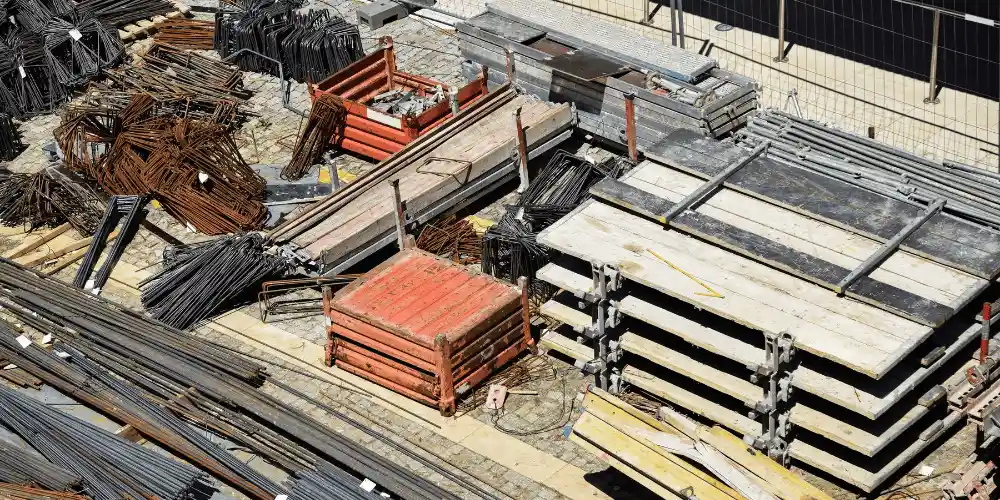Trade Wars and Home Prices: Why Trump’s Tariffs Are Driving Up Housing Costs
The Rising Cost of American Dreams
New home construction in the United States is set to face a significant financial squeeze, primarily due to the implementation of tariffs on key materials.
Anúncios
According to an analysis by John Burns Research and Consulting, these tariffs are likely to hike new home prices by an average of 5%, translating to an additional cost of approximately $21,000 per home.
Surge in Median Home Price
The escalating costs of construction materials have already contributed to a dramatic increase in the median home price, which has soared by 30% over the past five years, reaching an astonishing $427,000 in December 2024.
This hefty price tag is becoming increasingly unattainable for many, especially when you factor in the doubling of mortgage rates since the pre-pandemic period.
Anúncios
Higher interest rates mean higher monthly payments, pricing out a significant portion of potential homeowners.
Impact of Tariffs
| 🌍 Trade Dependency | 📊 Impact |
|---|---|
| 🔩 Hardware Imports | 60% of hardware used in construction comes from China, Canada, and Mexico. Tariffs increase import costs, leading to higher prices for builders. |
| 🪵 Sawmill Wood Products | 75% of sawmill wood products essential for homebuilding are imported from Canada. Tariffs raise costs for framing and construction materials. |
| 📈 Cost Inflation | Suppliers in affected countries must raise prices to cover new tariffs, increasing expenses across the construction industry. |
Wider Economic Impacts
The consequences don’t stop at imported goods.
Anúncios
Domestic suppliers, seeing the prices of tariff-affected imports rise, are likely to follow suit, increasing their prices simply because market conditions allow it.
This phenomenon exacerbates the already severe labor shortages plaguing the construction industry.
Homebuilders, unable to absorb these rising costs entirely, are forced to pass them on to consumers, further driving up home prices.
A Struggle for Home Affordability
As costs continue to climb, the dream of homeownership slips further away from many Americans.
With each new layer of financial burden – whether from tariffs, labor shortages, or rising interest rates – the end consumer bears more of the cost.
For individuals and families trying to purchase a home, these increases can mean the difference between achieving the American Dream and being priced out of the market.
The increased financial strain from construction costs and tariff policies underscores a critical need for stakeholders to reassess their strategies and find ways to mitigate impacts.
As we delve deeper into the housing market dynamics, the next area to explore will be the impact of construction material imports on the broader domestic market and housing affordability.
Impact on Construction Materials
The cost of construction materials has seen significant changes due to recent tariffs, and the impact is far-reaching.
Roughly 60% of all hardware imports that are crucial for homebuilding come from China, Canada, and Mexico.
This dependency on imports makes the construction industry particularly vulnerable to price fluctuations caused by trade policies.

Hardware Imports and Tariffs
Hardware components form the backbone of residential construction, and with 60% of these materials imported mainly from China, Canada, and Mexico, tariffs have a direct impact on the construction costs.
As tariffs increase the cost of these imports, domestic suppliers are likely to hike prices to match, simply because they can.
This creates a ripple effect throughout the industry, raising the overall cost of homebuilding materials.
Sawmill Wood Products
The housing industry’s reliance on Canadian sawmill wood products is significant, as nearly three-quarters of these materials are imported from Canada.
Tariffs not only increase the cost of these imports but also threaten the long-term viability of Canadian sawmill operations.
With a potential rise in operating costs, Canadian sawmills may struggle to sustain their business operations, further straining the already tight supply of lumber.
This will make it even harder for homebuilders to source essential wood products, creating additional pressure on the construction supply chain.
Household Appliances
Major household appliances, another key component of new homes, are heavily imported from Mexico.
These imports will also see price increases due to tariffs, impacting the overall cost of finishing a new home.
For many consumers, this adds another layer of financial strain as the cost of essential home appliances surges.
The increased costs of hardware, lumber, and appliances collectively add up, significantly inflating the expenses of home construction.
These additional expenditures challenge builders who are already dealing with high costs and labor shortages, making it difficult for them to fully absorb the added burden.
As a result, new home prices are likely to climb, exacerbating the existing affordability crisis.
The escalating costs of construction materials, compounded by tariffs, are putting immense pressure on both the construction industry and potential homeowners.
This not only impacts homebuilders but also creates a broader strain on the housing market, making homeownership more challenging for many Americans.
The ongoing issues with construction materials highlight the complex interplay between trade policies and domestic economic conditions.
As we look further into the ripple effects on domestic markets, additional factors come into play that shape the future of the housing industry.
Ripple Effects on Domestic Markets
The ongoing trade conflicts, particularly the tariffs imposed on imports from China, Canada, and Mexico, are causing significant ripple effects across domestic markets.
The construction industry is particularly affected, with domestic suppliers likely to raise prices to match tariff-affected imports, leading to a cascade of economic issues.
Price Hikes by Domestic Suppliers
Domestic suppliers are in a unique position where they can raise prices in response to increased costs of imported materials.
Since 60% of hardware imports come from China, Canada, and Mexico, and with three-quarters of imported sawmill wood products sourced from Canada, the rising costs due to tariffs will naturally influence domestic markets.
As Saunders pointed out, the mere threat of tariffs often compels domestic suppliers to elevate prices, matching those from tariff-affected countries.
Construction Industry Labor Shortages
The construction industry is currently battling severe labor shortages.
This issue is exacerbated by the added constraints and financial burdens introduced by tariffs.
With new tariffs in place, the uncertainty and increased costs impact various ingredients required for residential construction.
An additional complication is the high dependency on imported materials, which are now more expensive due to tariff increases.
These factors create an unsustainable environment for homebuilders, who cannot pass all additional costs to consumers without pricing out potential homebuyers.
Disruption of Potential Supply Increases
The threat of tariffs alone has already disrupted potential increases in supply.
Stinson Dean, an investor in the lumber market, notes that the long-term implications of making Canadian sawmill operations unviable due to increased costs will be substantial.
Eventually, when the housing demand rises, possibly due to lower mortgage rates, there won’t be enough production capacity to meet the demand.
This disruption concerns future availability and cost-effective supply, leading to tighter constraints on the housing market.
These ripple effects from the imposed tariffs provide a glimpse into the complexities and future challenges the domestic construction and housing markets face.
As tariffs linger, their reach extends beyond immediate cost hikes, influencing supply chain dynamics and market stability.
The affordability crisis worsens as these effects unfold, positioning potential homeowners and the industry in an increasingly precarious situation.
Long-term Consequences for Housing Supply
The Strain on Canadian Sawmill Operations
The impact of tariffs on essential construction materials, particularly from Canada, is profound.
Canadian sawmill operations, which are responsible for 75% of imported sawmill wood products in the United States, may become increasingly unviable due to rising costs associated with doing business in the U.S. market.
The tightening of trade relations as tariffs drive up expenses means many sawmill businesses could find it unsustainable to continue, affecting the future availability of lumber crucial for home construction.
Production Capacity Constraints
As the housing market responds to fluctuating demand, production capacity constraints become evident.
When consumer demand for new homes rises, exacerbated by plummeting mortgage rates, the industry’s capacity to meet this demand is hampered by existing constraints.
The tariffs have already imposed barriers to the effective stocking of materials and components needed for construction, effectively stalling potential enhancements in supply.
Concerns About Future Lumber Supply
The long-term implications of restricted Canadian lumber supply are particularly troubling.
If Canadian sawmills reduce their output or shutter operations entirely due to increased costs, the U.S. construction industry could face significant shortages of essential materials in the future.
With homebuilders struggling to keep up with the heightened expenses and labor shortages, the cost and feasibility of new constructions will likely worsen.
The Broader Impact
The tariffs have triggered a cascade of complications extending beyond immediate material costs.
Increased operational expenses and disruptions in import supply chains contribute to an ecosystem characterized by uncertainty and restricted capacity.
The future availability of affordable, reliable construction materials is now shadowed by the potential for continued supply deficits and further cost escalations, impeding industry growth and home accessibility.
The repercussions of these trade policies and economic adjustments create an environment where the typical American dream of homeownership becomes harder to attain, leading to an uncertain and challenging road ahead for both homebuilders and potential homeowners alike.
The net effect of these changes echoes across the housing market and underscores the gravity of the situation, setting the stage for further implications.
Affordability Crisis Ahead
Amplified Costs and Homebuilder Challenges
New tariffs have added an estimated $21,000 to the cost of constructing new homes.
For homebuilders, this increase looms large over their budgetary constraints.
Many simply cannot absorb these additional costs.
Already facing rising material prices, higher labor costs, and supply chain disruptions, homebuilders are in a bind.
Moreover, with the median home price already at $427,000—a 30% jump in just five years—these added expenses are the last thing they need.
The Vulnerability of Buyers
Higher home prices have a direct impact on potential buyers.
With mortgage rates now double what they were before the pandemic, the dream of owning a home is slipping further out of reach for many.
Housing affordability is becoming a significant issue as newly constructed homes carry substantial price tags due to these compounded costs.
Intersection of Market Conditions
The combined impact of tariffs and existing market conditions creates the perfect storm for an affordability crisis.
The increases in essential construction materials due to tariffs affect everything from hardware imports to household appliances, driving up costs across the board.
This has forced domestic suppliers to adjust their prices accordingly.
As noted in the prior chapters, 60% of hardware imports and 75% of sawmill wood products arrive from countries subject to these tariffs.
Tightening Supply and Rising Demand
Looking forward, the threats to affordable housing will only grow.
Should consumer demand rise—perhaps spurred by lower mortgage rates in the future—the production capacity to meet that demand won’t be there immediately.
Supply constraints, as a result of these amplified costs and disrupted supply chains, will limit the ability of homebuilders to construct new homes.
Stagnant supply and rising costs are a recipe for prolonged affordability issues within the housing market.
The economic environment is becoming increasingly unsustainable for both consumers wanting to buy homes and for businesses attempting to build them.
The repercussions of these circumstances will continue to echo throughout the market, burdening prospective homeowners and worsening the affordability crisis.
As we turn our attention to the broader implications, it’s clear that the intersecting challenges of supply, demand, and escalating costs create a complex landscape fraught with risks for the housing industry.





